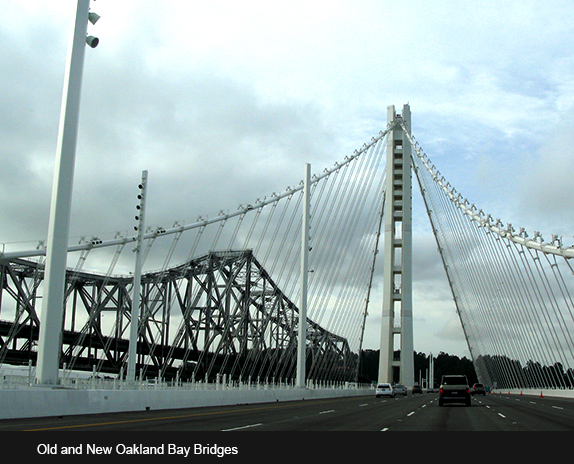
The San Francisco Bay area may have one of the most interesting skylines of any US American city. This is because it is a panorama of variously shaped buildings from a number of eras, bridges as unique as the Golden Gate, islands such as Treasure and Alcatraz, lush parks and gracefully interlocking bodies of water.
I recently visited San Francisco to launch new books and visit old friends. My partner and I stayed in Berkeley and most of our business and sightseeing was in San Francisco, so we came and went over the two very different spans of the Oakland Bay Bridge. The historic girders remain beside the beautiful sweep of the modern section’s suspended wings. Joseph E. Blum has been photographing this bridge for more than 50 years. It’s worth going on line and looking at his powerful images of workers and steel: the men who constructed the engineering marvel and the forms it’s taken through both its processes of creation.
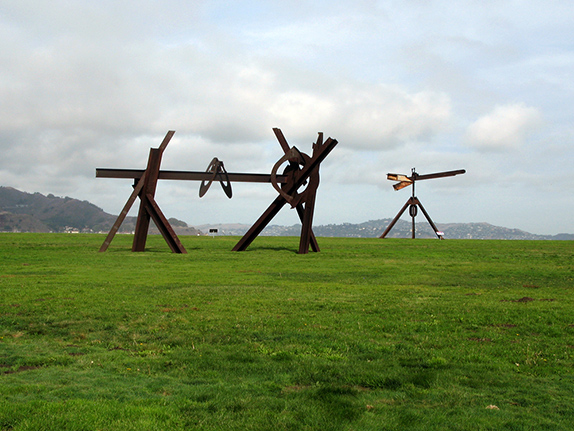
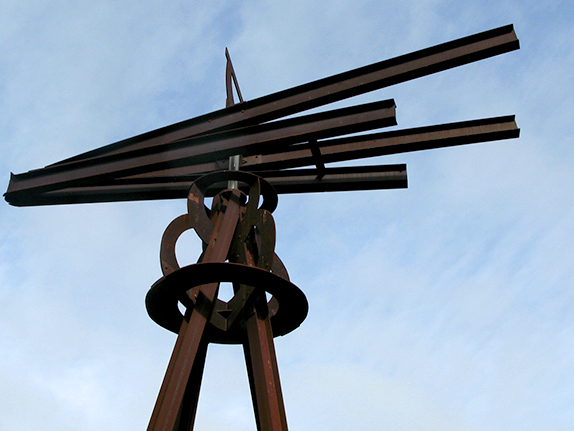
I knew an old friend, Mark di Suvero, had some of his immense sculptures in another part of the city: Crissy Field near another bridge, the famous Golden Gate. Mark di Suvero and I were friends at mid twentieth century, when we’d both arrived in New York City: he the incipient sculptor, I the incipient poet. We were among hundreds, perhaps thousands, of young creative artists just starting out in our respective fields. Like many, we earned our meager livings at whatever jobs brought in enough for rent, food, and art supplies. Mark often worked as a carpenter’s helper.
On a day I will never forget he was doing a job in a large midtown building. Riding atop a freight elevator, he guided a load of timber. When he shouted “Down” the guy operating the elevator—I later learned he was an Italian immigrant, not yet fluent in English—misunderstood and sent the load and Mark up into the machinery. It took hours for firefighters and police to extricate hid body from those great steel vices and jaws. His spine was crushed. I became one of a small group of friends who accompanied Mark at Roosevelt Hospital, periodically helping to turn his body and keep his spirits up. Doctors said he would never walk again.
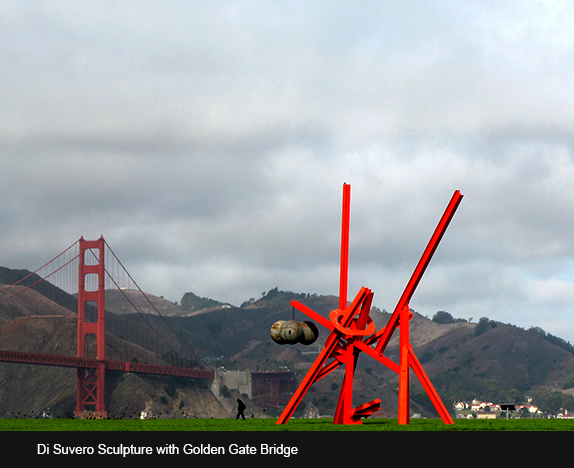
Mark di Suvero spent months in Roosevelt Hospital and close to a year at a rehabilitation facility. But he did walk again. And eventually he made a name for himself as one of my generation’s great sculptors, producing massive works, themselves constructed of steel beams and gear-like shapes, often using the leftovers from bridges and buildings. We haven’t been in touch for half a century, but now I discovered that a series of his mammoth metal sculptures are on display across this landscape that runs between city and water.
San Francisco’s Museum of Modern Art, in partnership with the National Park Service and the Golden Gate National Parks Conservancy, join in hosting this year-long display. It opened in May of this year and will run through May 2014. The eight large pieces celebrate five decades of the sculptor’s production, from 1967 (about a decade after his accident) to 2012. All are immense, but very different from each other in feel as well as in construction. Some favor right angles while others incorporate circular shapes. Set against the backdrop of the famous bridge—a structure, it turns out, that has inspired the artist throughout his career—di Suvero’s dynamic pieces frame and reframe the surrounding landscape in surprising ways.
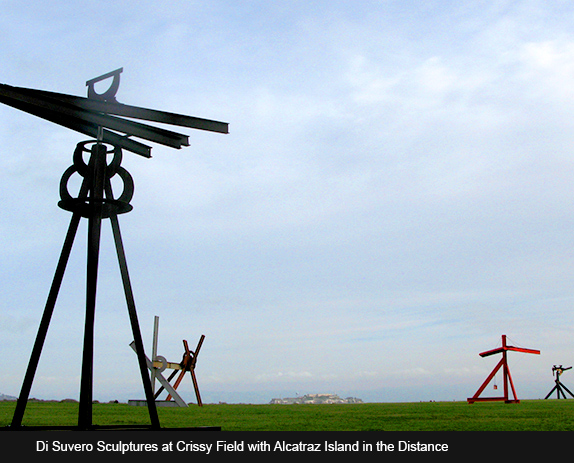
It had been raining, and the grassy field was sodden beneath a cloudy sky. Occasional streaks of sun or clear blue caught a sculptural angle as they animated a few joggers, a man out with his dogs, and one or two visitors who—like us—seemed to have come especially for the art. Along the edge of the bay a line of old wooden buildings kept their memories behind shuttered windows and doors. In the distance I spotted Alcatraz Island, its fortress-like prison long since reclaimed by the American Indian Movement. Now every Thanksgiving Indians and non-Indians make their yearly pilgrimage to the site for a pre-dawn ceremony. Later in the week one of the organizers told me this year they expect 4,000.
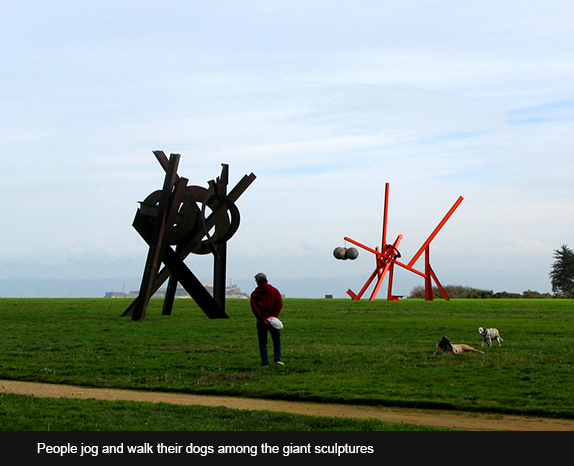
Spending an hour or so among my old friend’s sculptures brought up many memories. I thought about how artists in all genres work against enormous odds in a society that rarely recognizes their talent unless or until it produces market commodities. I thought about how most of us are encouraged—by parents, even teachers and mentors—to keep our “day jobs” in order to “have something to fall back on” if we cannot make it as artists. I thought about how some of us—Mark in particular with that accident that almost took his life and mobility—must overcome additional obstacles of all sorts. And I thought about the few whose talent, creative energy and insistent work pull them through those barriers—because we cannot conceive of not doing what we know we were meant to do.
I stood beneath one of the tallest sculptures and aimed my camera up into its swirl of steel, searching for slices of sky. I looked over at a single gorgeous tree, and wondered what it takes for human-made art to rival the beauty of nature. Whether bridge or building or super-sized sculpture, challenging a tree or rock formation or shoreline is risky business. It requires just the right degree of confidence, accomplishment, and lack of arrogance. Sometimes it works. Sometimes it doesn’t.
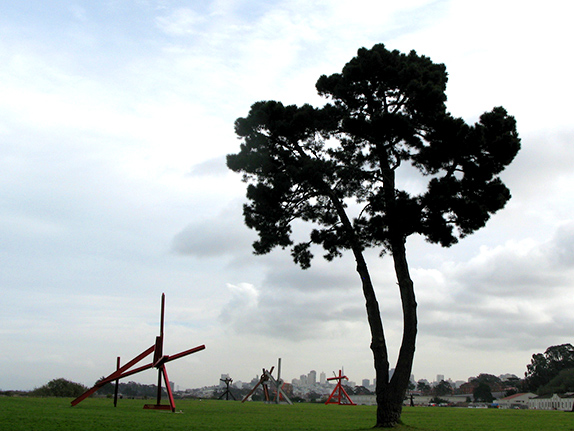
Late twentieth and twenty-first century art installations have become more and more grand. Some, like Walter de Maria’s Lightning Field, here in New Mexico, are meant to create an experience; visitors are taken in small groups to a cabin where they spend the night. They are invited to walk around and among the evenly placed metal poles that have changed the landscape on which they stand.
Others, like Andy Goldsworthy’s ephemeral sculptures, are as respectful as de Maria’s seems to impose themselves upon the land. They are created, photographed, and then either destroyed or allowed to be devoured by nature. In the Presidio section of San Francisco, in 2008, Goldsworthy created a spire of 37 steel-armatured cypress tree trunks that had been felled as part of the area’s reforestation program. The artist has said that it taps into the architecture of a tree but also the architecture of buildings.
A great deal can be learned about a city by its proliferation of public art. And a great deal can be learned about an artist by his or her respect for the terrain on which monumental art is built.
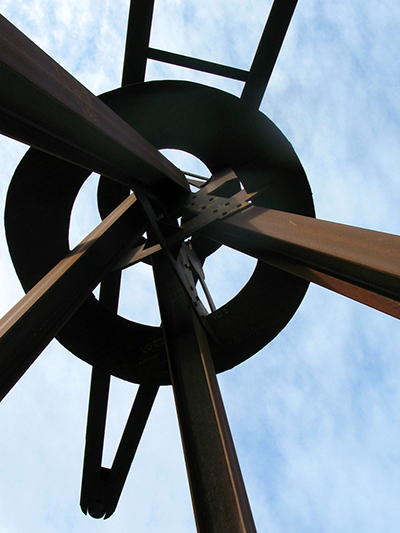




Responses to “Friday Voyage: When Art Inhabits Land - Part 1”